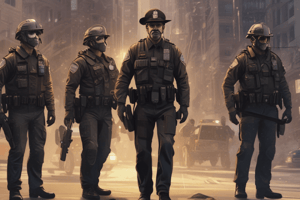Podcast
Questions and Answers
What is a key sign of cardiac arrest within the first 5-6 minutes?
What is a key sign of cardiac arrest within the first 5-6 minutes?
- Hyperoxia in the brain
- Rising blood pressure
- Increased heart rate
- Brain begins to suffer from hypoxia (correct)
In the case of an infant, what is the correct compression-to-breath ratio during CPR?
In the case of an infant, what is the correct compression-to-breath ratio during CPR?
- 15 compressions: 2 breaths
- 30 compressions: 2 breaths (correct)
- 20 compressions: 1 breath
- 10 compressions: 1 breath
Which type of shock is characterized by a failure of the heart to pump effectively?
Which type of shock is characterized by a failure of the heart to pump effectively?
- Distributive shock
- Cardiogenic shock (correct)
- Neurological shock
- Hypovolemic shock
What is the primary role of beta-2 receptors in the body?
What is the primary role of beta-2 receptors in the body?
What does the term 'compensated shock' refer to?
What does the term 'compensated shock' refer to?
When should a meter-dose inhaler (MDI) be appropriately utilized?
When should a meter-dose inhaler (MDI) be appropriately utilized?
Which statement best differentiates myocardial infarction (MI) from angina?
Which statement best differentiates myocardial infarction (MI) from angina?
Which structure of the heart is NOT a pacemaker site?
Which structure of the heart is NOT a pacemaker site?
What part of the autonomic nervous system is responsible for the 'fight or flight' response?
What part of the autonomic nervous system is responsible for the 'fight or flight' response?
What sequence correctly describes the flow of blood through the heart?
What sequence correctly describes the flow of blood through the heart?
Which statement correctly distinguishes Type 1 diabetes from Type 2 diabetes?
Which statement correctly distinguishes Type 1 diabetes from Type 2 diabetes?
What are common signs and symptoms associated with hyperglycemia?
What are common signs and symptoms associated with hyperglycemia?
What is the total count of vertebrae in the cervical region of the spine?
What is the total count of vertebrae in the cervical region of the spine?
What is a major function of the left ventricle in the heart?
What is a major function of the left ventricle in the heart?
Which of the following is a defining characteristic of a transient ischemic attack (TIA)?
Which of the following is a defining characteristic of a transient ischemic attack (TIA)?
What role does the large intestine primarily fulfill in the digestive system?
What role does the large intestine primarily fulfill in the digestive system?
What is the first priority in ensuring scene safety?
What is the first priority in ensuring scene safety?
Who has the ultimate authority over EMS practice scope?
Who has the ultimate authority over EMS practice scope?
What is required for a Do Not Resuscitate (DNR) order to be considered valid?
What is required for a Do Not Resuscitate (DNR) order to be considered valid?
When can a patient refuse consent for medical treatment?
When can a patient refuse consent for medical treatment?
What defines an occluded airway?
What defines an occluded airway?
What are signs of inadequate breathing?
What are signs of inadequate breathing?
What does VPU stand for in patient assessment?
What does VPU stand for in patient assessment?
What is a normal capillary refill time for an adult?
What is a normal capillary refill time for an adult?
What is the function of the stomach?
What is the function of the stomach?
What does GCS stand for and what does it assess?
What does GCS stand for and what does it assess?
What is the primary indication for using a traction splint?
What is the primary indication for using a traction splint?
What are the signs of a pelvic or hip fracture?
What are the signs of a pelvic or hip fracture?
Which letter in the APGAR score represents Respiratory effort?
Which letter in the APGAR score represents Respiratory effort?
What happens during the third stage of labor?
What happens during the third stage of labor?
What is a critical action to take in case of overdose with pills?
What is a critical action to take in case of overdose with pills?
What is the immediate treatment for a sucking chest wound?
What is the immediate treatment for a sucking chest wound?
What key function does epinephrine perform during an anaphylactic reaction?
What key function does epinephrine perform during an anaphylactic reaction?
What distinguishes a concussion from a traumatic brain injury (TBI)?
What distinguishes a concussion from a traumatic brain injury (TBI)?
When treating an abdominal evisceration, what should not be done?
When treating an abdominal evisceration, what should not be done?
What is the first step to take when dealing with a poisoning incident?
What is the first step to take when dealing with a poisoning incident?
Which of the following is NOT a method the body uses to cool itself during a heat emergency?
Which of the following is NOT a method the body uses to cool itself during a heat emergency?
In the assessment of burns, which symptom is associated with 3rd degree burns?
In the assessment of burns, which symptom is associated with 3rd degree burns?
What symptom is NOT typically associated with nerve agent exposure?
What symptom is NOT typically associated with nerve agent exposure?
What is a key difference between arterial and venous bleeding?
What is a key difference between arterial and venous bleeding?
Flashcards are hidden until you start studying
Study Notes
Scene Safety and Consent
- Scene safety is the foremost priority; assess for hazards before proceeding.
- EMS scope of practice is controlled by the medical director and state regulations.
- A Do Not Resuscitate (DNR) order is valid when signed by a physician and includes patient identification.
- Individuals can deny consent if conscious and competent or if they possess a valid DNR.
- Implied consent applies in emergencies when the patient is unconscious, while expressed consent is a clear agreement given by a competent adult.
Airway and Breathing
- Airflow follows the pathway: Nose/Mouth → Pharynx → Larynx → Trachea → Bronchi → Lungs.
- An occluded airway is a complete blockage that hinders airflow.
- Different breathing sounds signify various conditions:
- Wheezing indicates constricted airways.
- Stridor suggests upper airway obstruction.
- Crackles point to fluid in the lungs.
- Rhonchi suggest mucus in airways.
- Agonal breathing consists of infrequent, ineffective gasps; begin CPR and provide ventilations immediately.
Respiratory Support
- CPAP is indicated for conditions like CHF and COPD but contraindicated in situations such as facial trauma or unconsciousness.
- Breathing is crucial for supplying oxygen, essential for cellular respiration.
Vital Signs and Assessment
- Normal vital signs include a pulse of 60-100 bpm, respiratory rate of 12-20/min, and blood pressure of 90-140/60-90.
- Inadequate breathing may present with cyanosis, altered mental status, and decreased respiratory rate.
- Capillary refill time for females should be 1-2 seconds.
Trauma and Emergency Response
- The order of trauma assessment is primary assessment, followed by secondary and tertiary assessments.
- Rib fractures may show localized tenderness, pain during inspiration, and crepitus.
- Meter-dose inhalers (MDIs) should be used for asthma or COPD exacerbations but not for acute severe respiratory distress.
Cardiovascular System
- Beta-1 receptors increase heart rate and contractility, while beta-2 receptors cause bronchodilation.
- In cardiac arrest, brain hypoxia begins after 5-6 minutes, shifting cellular metabolism to anaerobic processes.
- Signs of shock include tachycardia, cool, clammy skin, and increased respiratory rates.
Neurological and Endocrine Considerations
- TIA (Transient Ischemic Attack) features temporary stroke-like symptoms; CVA (Cerebrovascular Accident) results in permanent damage.
- Insulin, produced by the pancreas, regulates blood glucose levels; its absence leads to hyperglycemia, characterized by increased thirst and frequent urination.
Pediatric Considerations
- For a 10-month-old, the Rule of 9s allocates 18% to the head, 9% to each arm, 14% to each leg, and 18% to both anterior and posterior trunk.
- Signs of dehydration in infants include dry mouth, lack of tears, and sunken eyes.
Trauma Management
- A sucking chest wound should be sealed with an occlusive dressing to ensure it's airtight.
- Treat joint dislocations by immobilizing the joint, applying ice, and seeking medical help.
Pharmacology and Treatment
- Epinephrine use is indicated in anaphylaxis; contraindications are minimal in life-threatening scenarios.
- Aspirin is indicated for chest pain suggesting myocardial infarction (MI) but is contraindicated in active bleeding and allergies.
Burns and Poisoning
- For first, second, and third-degree burns, symptoms vary from redness and pain to blisters, swelling, and numbing.
- In case of poisoning, contact poison control and never induce vomiting unless directed.
Emergency Vehicle Operation
- "Driving with due regard" involves operating emergency vehicles cautiously and prioritizing the safety of all road users.
Hazardous Materials
- Familiarize with classifications and characteristics to handle hazards appropriately during emergencies.
Studying That Suits You
Use AI to generate personalized quizzes and flashcards to suit your learning preferences.




